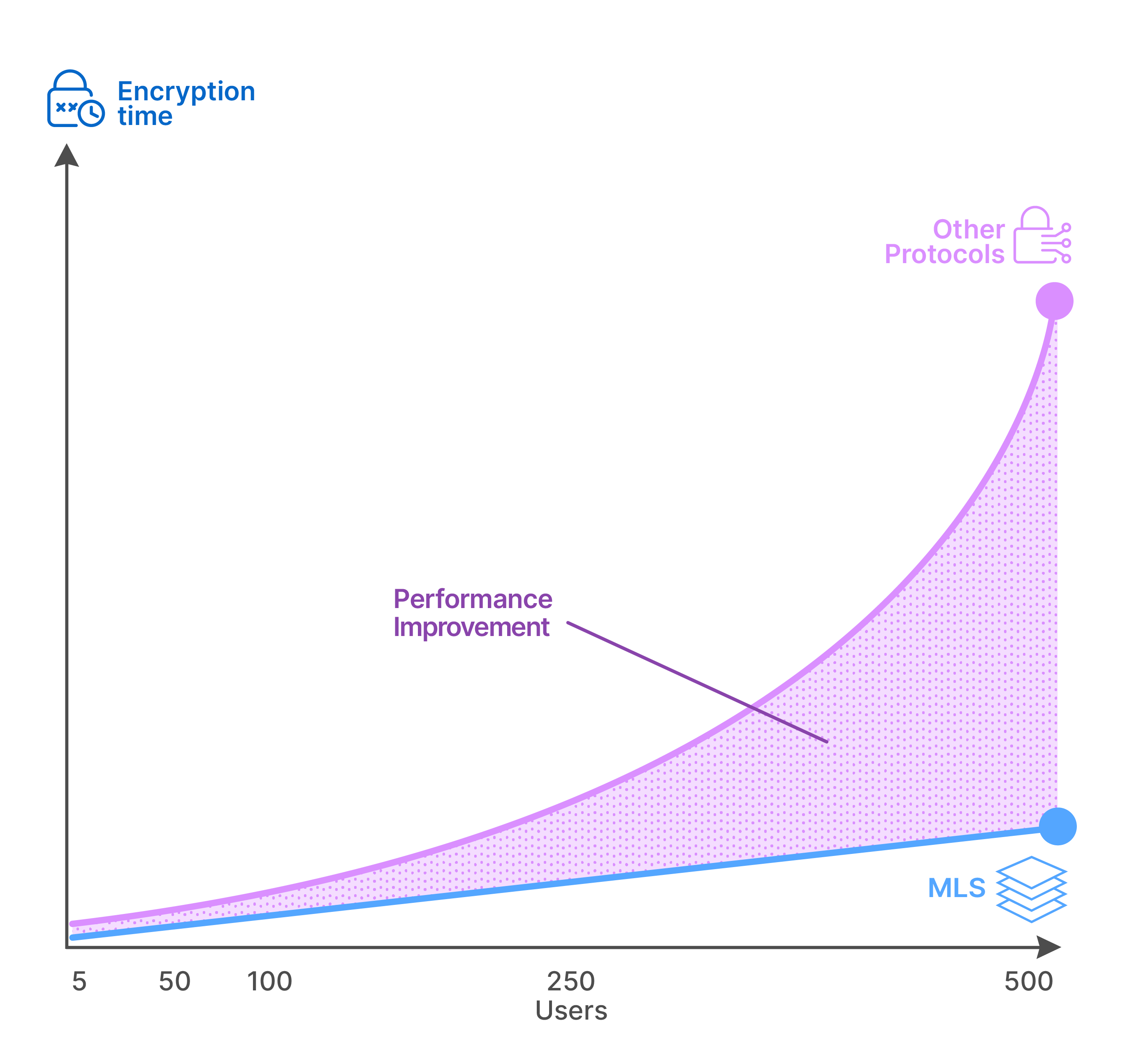Simply secure
End-to-end encryption gives you the confidence to talk, message, and share documents across teams and with clients through a single app — available on all your devices.

German government endorses Wire
In our collaboration, we are used by tens of thousands of German government employees. All governmental institutions can use Wire for their sensitive communication.
Compliance requirements
As all data is encrypted, there’s no risk of it reaching third parties (including Wire) and your organization is fully compliant with the European privacy legislation.Data thriftiness
Wire doesn’t collect or store unnecessary user data. The data we need from you makes sure you can use Wire properly.

Scalable, verified security by design
- Enterprise-grade protection: Wire is the only platform fully secured by MLS, co-developed for secure collaboration.
- Full-feature MLS coverage: Messages, calls, and files are end-to-end encrypted by default.
- Scales with your teams: MLS supports large groups with fast, efficient key exchange.
- Post-quantum ready: Built for cryptographic agility to withstand future threats.
- Open-source and auditable: Wire’s MLS code is fully transparent and verifiable.
Protect your communication and document sharing
- All communication through Wire is end-to-end encrypted - messages, conference calls, and files.
- Each message is encrypted with a new key. No one, except the participants in a conversation can decrypt information.
- Wire’s encryption works transparently in the background and doesn’t need to be activated - it’s always on.
Learn more in Wire’s Security Whitepaper


Open and verifiable
Wire’s source code is fully transparent and 100% open source. It is available on GitHub for anyone to verify. All our development is open to the public — collaborate with the team and follow our commits, pull requests, issues, and discussions on GitHub.
ISO 27001 & ISO 27701 certification
Wire is proudly ISO 27001 and ISO 27701 certified, demonstrating our commitment to protecting your data and privacy. These internationally recognized certifications ensure confidentiality, integrity, and compliance with regulations like GDPR, helping our customers confidently manage risk and enhance trust in our secure communication platform.
.png)
European data sovereignity
Wire’s servers are in Germany and Ireland. The hosting provider’s server locations are secured following the highest standards and hold certifications such as ISO 27001, FedRAMP, FIPS 140-2, NIST 800-17. The hosting providers are fully compliant with all applicable European Data Protection laws.


Privacy by design
- Your privacy is always our priority. Wire does not sell analytics or usage data to anyone.
- Physical, electronic, and procedural safeguards are provided to protect your information.
- Wire stores only the data needed to ensure your conversations stay in sync across devices and troubleshoot issues.
- We’re transparent about the data we collect, and what we use it for. Wire uses end-to-end encryption for all messages, media, and calls, as well as Secure Real-Time Transport Protocol (SRTP) with Datagram Transport Layer Security (DTLS) for end-to-end calling encryption.
See Wire’s Security Whitepaper and Privacy Whitepaper for more details about the encryption methods and how Wire protects your privacy.
Frequent code inspection
Wire is committed to working with independent security experts to perform regular audits of different components of our app.- Cryptography review & penetration test AVS, cure53, June 2024
- Cryptography review & code audits Wire OpenMLS Port, cure53, June 2024
- Cryptography review & code audits core-crypto, cure53, June 2024
- iOS app, modzero, March 2023
- Desktop app, modzero, March 2023
- Wire for web, modzero, February 2023
- Proteus (cryptobox implementation), modzero, February 2023
- Audio Video Signaling (AVS), modzero, February 2023
- Android app (Kotlin), modzero, January 2023
- Android app (Scala), modzero, January 2022
End-to-end identity with ID Shield
Wire’s ID Shield confirms you're speaking with the right contact. Device checks are automatic and based on certificates, removing the need for manual fingerprint comparisons while ensuring secure identity validation.
Trusted conversations
Verify each conversation partner’s device fingerprints for maximum security. It helps to protect you from a man-in-the-middle attack by ensuring that the person you are communicating with is who they say they are. After verifying a conversation, you will be alerted if your contact starts using Wire on a new device.
Multi-device management
You can use your Wire account on up to 8 devices with your contacts and conversations always in sync. Log in to your Wire account on mobile, desktop, browser, or tablet to add another device to your device list. You can manage the devices associated with your account at any time.
Why is Wire secure?
Wire is a secure messaging app that uses end-to-end encryption (E2EE) for all communications—including messages, calls, and file sharing—ensuring only participants can decrypt the information. E2EE is always enabled by default and cannot be disabled. Wire's open-source code allows anyone to verify its security protocols.
Message Encryption:
Wire employs the Proteus protocol, its implementation of the Axolotl/Double Ratchet protocol, to secure messages between clients. By utilizing pre-keys, Wire allows encrypted conversations to start even when both parties are not online simultaneously. The Proteus protocol incorporates robust cryptographic primitives:
- ChaCha20 Stream Cipher
- HMAC-SHA256 for message authentication codes
- Curve25519 for elliptic curve Diffie-Hellman key exchange
- HKDF for key derivation functions
Media Encryption:
For one-to-one audio and video calls, Wire uses the Secure Real-time Transport Protocol (SRTP), with encryption keys and parameters negotiated through a Datagram Transport Layer Security (DTLS) handshake. Client authenticity is verified via fingerprint exchange over authenticated Proteus sessions. Conference calls are similarly encrypted but leverage Insertable Streams for E2EE of media packets, using:
- AES-GCM 256 for payload encryption
- HKDF-SHA512 for key derivation
Forward Secrecy (FS) & Post-Compromise Security (PCS):
Wire ensures that all communications benefit from Forward Secrecy (FS) and Post-Compromise Security (PCS):
- Forward Secrecy (FS): Even if an encryption key is compromised, past communications remain secure because each message is encrypted with a unique key.
- Post-Compromise Security (PCS): After detecting a security breach and replacing compromised keys, future communications remain secure, safeguarding against attackers who had access to earlier sessions.
See Wire’s Security Whitepaper for more technical details about the encryption protocols. Or visit our help center to get more details.
Which data does Wire need?
Wire is committed to user privacy by collecting only the minimal data necessary to sync conversations across devices and troubleshoot issues. User profiles include:
- Registration email
- Username
- Profile name
Upon registration, Wire stores metadata per device to enhance notification clarity:
- Device class (mobile, tablet, desktop)
- Device model (for example, iPhone 14)
- User-defined device label
- Cookie label for authentication
- UTC timestamp of device registration
For more details please see Wire’s Privacy Whitepaper.
Does Wire protect against Man-in-the-Middle (MITM) attacks?
Wire allows users to verify conversations by comparing unique key fingerprints for each client. This process ensures that you're communicating with the intended recipient and helps prevent man-in-the-middle (MITM) attacks. After verification, you'll receive alerts if your contact starts using Wire on a new device.
Learn more about Wire’s crypto protocol
How does Wire protect my data?
Wire uses end-to-end encryption for all messages, media, and calling. We use Secure Real-Time Transport Protocol (SRTP) with Datagram Transport Layer Security (DTLS) for end-to-end calling encryption.
Wire's mobile applications utilize operating system push notification services—Apple Push Notification Service (APN) for iOS and Firebase Cloud Messaging Service (FCM) for Android—to notify the app of updates. Importantly, Wire does not share any message or call data with these services. The app connects directly to Wire's servers to receive E2EE messages. Users preferring not to rely on external push services can download the F-Droid version of the Wire app, which avoids FCM and uses websockets for notifications.
See Wire’s Security Whitepaper and Privacy Whitepaper for more details about the encryption methods Wire uses and about how Wire protects your privacy.
See Wire in action
Discover how Wire enables secure, compliant, and seamless collaboration for your team - without compromising usability or control.